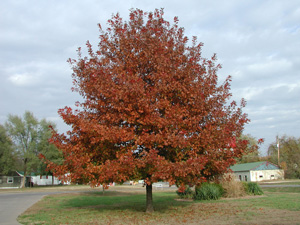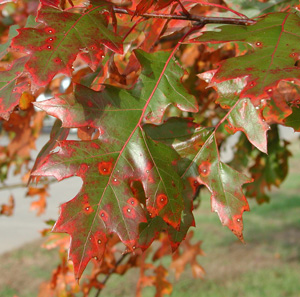Resource Library
Plant of the Week: Shumard Oak
The University of Arkansas System Division of Agriculture does not promote, support or recommend plants featured in "Plant of the Week." Please consult your local Extension office for plants suitable for your region.
Plant of the Week
Shumard Oak
Latin: Quercus shumardii

Choosing the perfect shade tree involves lots of compromise. In my mind the perfect shade tree would be strong, drought-resistant, deep-rooted, statuesque and live a thousand years, plus be fast growing, easy to transplant and available from every nurseryman. Putting this together in one package is hard if not impossible so compromise is inevitable. Shumard oak (Quercus shumardii) is a contender for being the perfect tree in some regards but falls short in other instances.
Shumard oak is one of the 40 some species of oaks native to Arkansas; in fact it is shown as being found in every county in the state. It is a member of the red oak tribe and typically grows 60 to 80 feet tall and 40 to 50 feet wide with a pyramidal form while young. Trees have large coarse leaves and, at least to me, a kind of brooding appearance in the landscape. It is one of the largest of the red oak species. With age the tree form becomes less pyramidal in outline and more round-headed but its lower limbs never droop as it grows as is seen in pin oak (Q palustris). As a member of the red oak tribe trees usually live to less than 150 years old.
Leaves of shumard oak are dark green, 6 to 8 inches in length with 5 to 9 prominent lobes, each of which is tipped with a long slender bristle. Fall color comes on late and is usually in shades of red or brown, but sometimes yellows are mixed in, or entire trees may be yellow. The fall color display is good but not as spectacular as seen in scarlet oak or pin oak. Shumard oaks are heavy acorn producers and the acorns are about an inch long and the width of a man’s thumb.

Shumard oaks are native to the southern region, and were they to extend into North Carolina and Virginia; their distribution would closely follow the lines of the Confederacy during the Civil War. It typically occurs along stream banks and even in somewhat swampy positions but, surprisingly, the tree has great drought tolerance. It is named for Benjamin Franklin Shumard (1820 – 1869), a physician-turned-paleontologist and geologist who worked on a number of state geological surveys including Iowa, Wisconsin, Minnesota, Missouri and finally Texas where he headed their geological efforts until being fired by Sam Houston.
This tree has earned a place of honor amongst arborists looking for large, tough trees that have to fend for themselves. Unlike pin oak, shumard oak thrives under both acidic and alkaline conditions and never shows the iron deficiency so common in pin oaks when the pH is above 6.8. Because of this tolerance for alkaline conditions and its ability to withstand drought it is a widely recommended tree for Texas, Oklahoma and Kansas where such conditions are common. In built landscapes, such as parking lots and such where lots of limestone gravel is used during construction, shumard oaks often outperform other oaks because of their ability to withstand the elevated pH conditions.
Shumard oaks are big trees and should only be planted where their largeness can be accommodated in the landscape. Any reasonable garden soil will work for them. They should not be planted closer than 20 feet from a structure. It is easy to transplant and is available as both specimen size balled and burlapped trees or in containers. Shumard oak is moderately fast growing averaging one to two feet per year after the plant is established. Though readily available in the nursery trade, it is not offered in every retail nursery.
By: Gerald Klingaman, retired
Retired Extension Horticulturist - Ornamentals
Extension News - November 16, 2012
The University of Arkansas System Division of Agriculture does not maintain lists of retail outlets where these plants can be purchased. Please check your local nursery or other retail outlets to ask about the availability of these plants for your growing area.